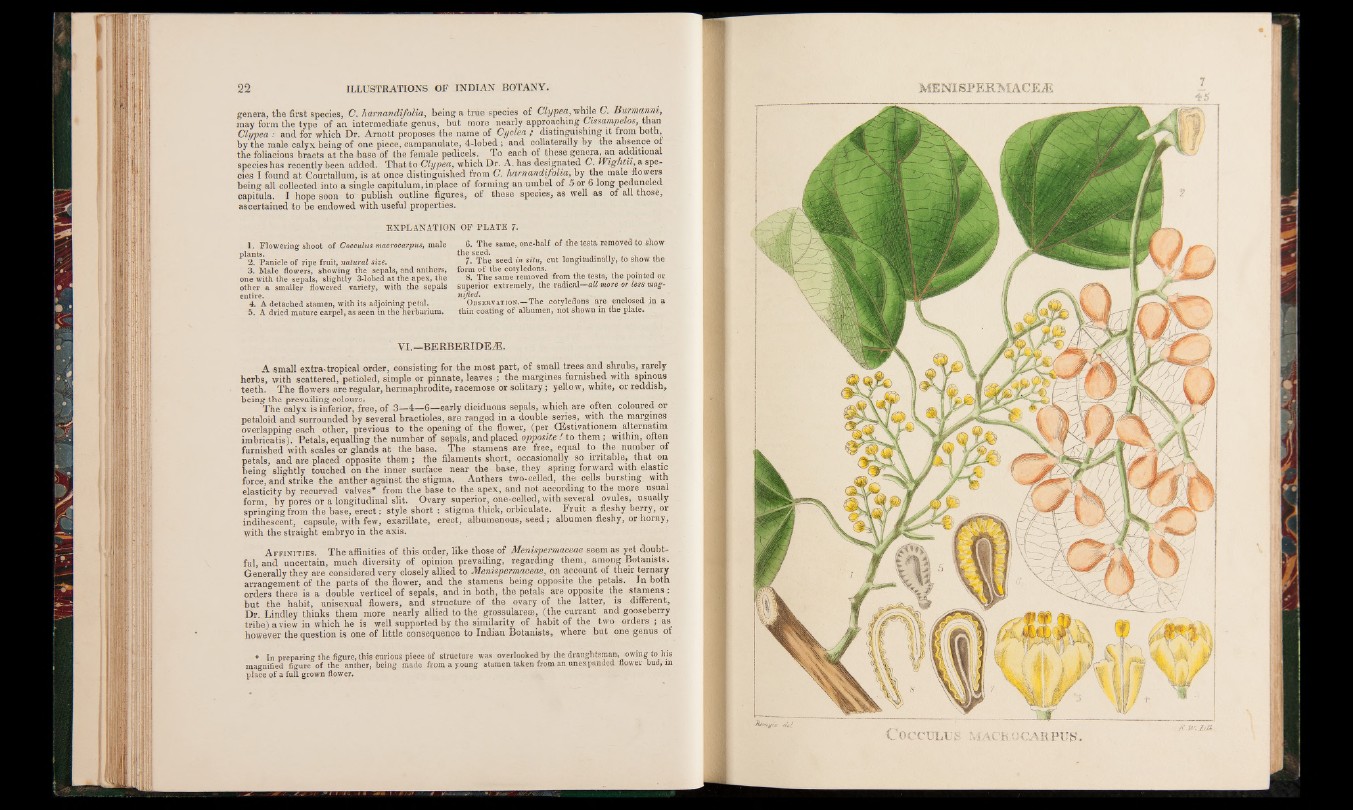
genera, the first species, C. harnandifolia, being a true species of Clypea, while C. Burmanni,
may form the type of an intermediate genus, but more nearly approaching Cissampelos, than
Clypea : and for which Dr. Arnott proposes the name of Cyclea ; distinguishing it from both,
by the male calyx being of one piece, campanulate, 4-lobed ; and collaterally by the absence of
the foliacious bracts at the base of the female pedicels. To each of these genera, an additional
species has recently been added. That to Clypea, which Dr. A. has designated C. Wightii, a species
I found at Courtallum, is at once distinguished from C. harnandifolia, by the male floweis
being all collected into a single capitulum, in,place of forming an umbel of 5 or 6 long peduncled
capitula. I hope soon to publish outline figures, of these species, as well as of all those,
ascertained to be endowed with useful properties.
EXPLANATION OF PLATE 7.
1. Flowering shoot of Cocculus macrocarpus, male
plants.
2. Panicle of ripe fruit, natural size.
3. Male flowers, showing the sepals, and anthers,
one with the sepals, slightly 3-lobed at the apex, the
other a smaller flowered variety, with the sepals
entire.
4. A detached stamen, with its adjoining petal.
5. A dried mature carpel, as seen in the herbarium.
6. The same, one-half of the testa removed to show
the seed.
7. The seed in situ, cut longitudinally, to show the
form of the cotyledons.
8. The same removed from the testa, the pointed or
superior extremely, the radical—all more or less magnified.
Observation.—The cotyledons are enclosed in a
thin coating of albumen, not shown in the plate.
VI.—BERBERIDEA3.
A small extra-tropical order, consisting for the most part, of small trees and shrubs, rarely
herbs, with scattered, petioled, simple or pinnate, leaves ; the margines furnished with spinous
teeth. The flowers are regular, hermaphrodite, racemose or solitary; yellow, white, or reddish,
being the prevailing colours. — ,
The calyx is inferior, free, of 3—4—6—early diciduous sepals, which are often coloured or
petaloid and surrounded by several bractioles, are ranged in a double series, with the margines
overlapping each other, previous to the opening of the flower, (per (Estivationem alternatim
imbricatis). Petals, equalling the number of sepals, and placed opposite g to them; within, often
furnished with scales or glands at the base. The stamens are free, equal to the number or
petals, and are placed opposite them ; the filaments short, occasionally so irritable, that on
being slightly touched on the inner surface near the base, they spring forward with elastic
force, and strike the anther-against the stigma. Anthers two-celled, the cells bursting with
elasticity by recurved valves* from the base to the apex, and not according to the more usual
form, by pores or a longitudinal slit. Ovary superior, one-celled, with several ovules, usually
springing from the base, erect: style short : stigma thick, orbiculate. Fruit a fleshy berry, or
indihescent, capsule, with few, exarillate, erect, albumenous, seed; albumen fleshy, or horny,
with the straight embryo in the axis.
A f f in it ie s . The affinities of this order, like those of Menispermaceae seem as yet doubtful,
and uncertain, much diversity of opinion prevailing, regarding them, among Botanists.
Generally they are considered very closely allied to Menispermaceae, on account of their ternary
arrangement of the parts of the flower, and the stamens being opposite the petals. In both
orders there is a double verticel of sepals, and in both, the petals are opposite the stamens:
but the habit, unisexual flowers, and structure of the ovary of the latter, is different,
Dr. Lindley thinks them more nearly allied to the grossulareae, (the currant and gooseberry
tribe) a view in which he is well supported by the similarity of habit of the two orders ; as
however the question is one of little consequence to Indian Botanists, where but one genus of
* In preparing the figure, this curious piece of structure was overlooked by the draughtsman, owing to his
magnified figure of the anther, being made from a young stamen taken from an unexpanded flower bud, in
place of a full grown flower.